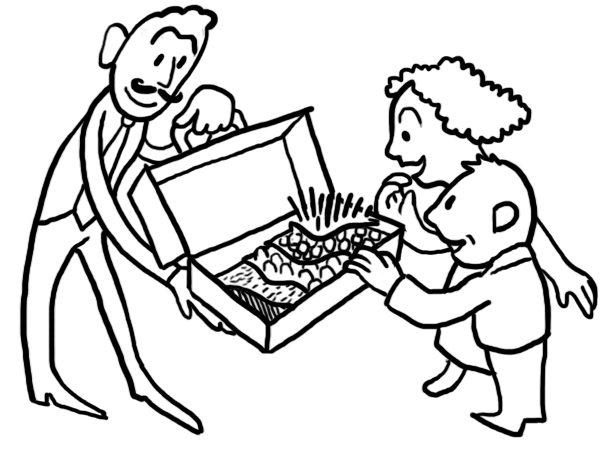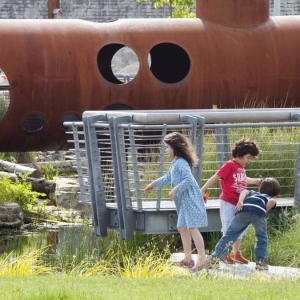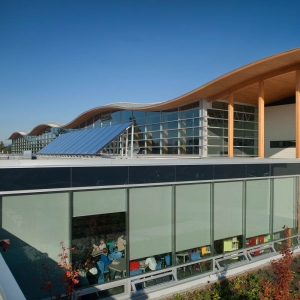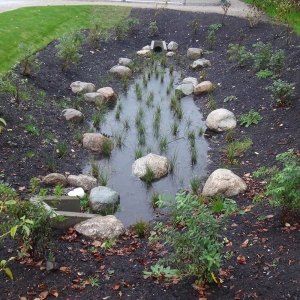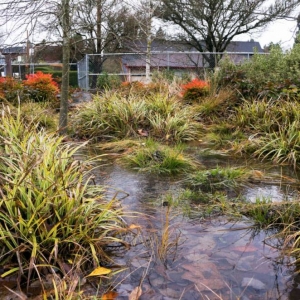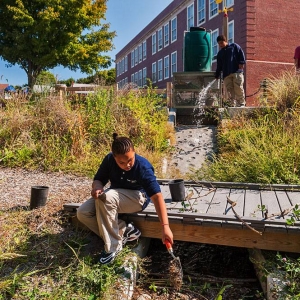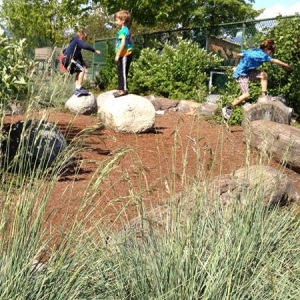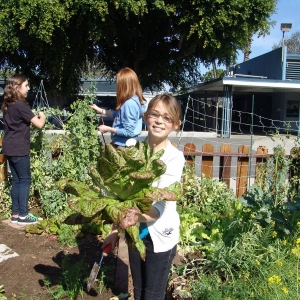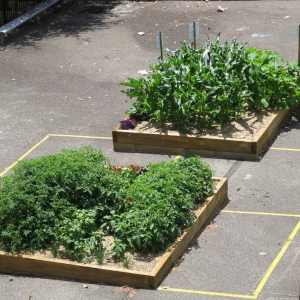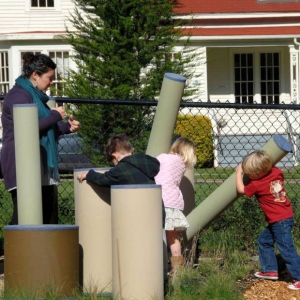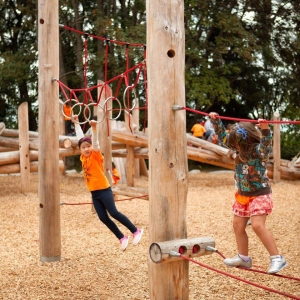Sustainability
The issue of sustainability is a pretty broad one. In landscapes and outdoor construction, it means trying to make the most of every opportunity to be kind to the environment. This can include choosing materials that have a low carbon footprint to reduce our impact on climate change, smart water management to keep our local waterways clean, using recycled objects to keep them out of the landfill (and reduce the cost of a project), choosing plants that don’t need much maintenance or irrigation, and many other clever strategies. Sustainability is good for the planet, sets a good example for our children, and it means that we’ll be able to leave them a better place to live, learn, and grow.
 Planting a new tree in the asphalt
(Folly Forest | Straub Thurmayr Landscape Architects and Urban Designers)
Planting a new tree in the asphalt
(Folly Forest | Straub Thurmayr Landscape Architects and Urban Designers)
Stormwater Management
Rain and where it goes after it hits the ground is not something most people think about. In the natural world, most of it soaks into the ground, absorbed by the roots of plants. In a city, however, most surfaces are paved and water can’t get through. It flows over asphalt roads, gets diverted into storm sewers, and eventually makes its way to outlets that dump the water (and all the dirty contaminants it collects along the way) into local waterways. Gross, right?
Green infrastructure can be used to keep that water out of storm sewers, and instead collect it on site and allow it to soak into the ground like it’s supposed to. Some schools are doing this as a way to be sustainable, and also using it as a learning opportunity to teach kids about water cycles. There are a lot of ways to manage stormwater: you can use permeable paving, rain garden, bioswales, cisterns, and many other techniques to manage rainwater sustainably at your school.
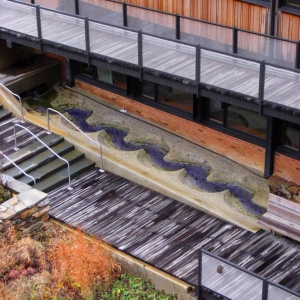 This channel comes to life every time it rains
(Sidwell Friends School | Andropogon Associates, Ltd.)
This channel comes to life every time it rains
(Sidwell Friends School | Andropogon Associates, Ltd.)
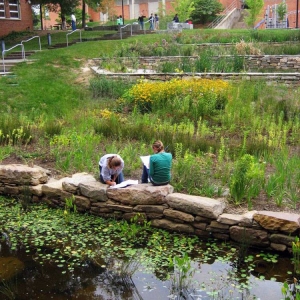 The plants in this rain garden and pond purify the water
(Sidwell Friends School | Andropogon Associates, Ltd.)
The plants in this rain garden and pond purify the water
(Sidwell Friends School | Andropogon Associates, Ltd.)
Native Planting
Using native plants from your region is a great opportunity to teach kids about their local ecosystems. Native plants are also well-suited to survive and thrive in the local climate, and that leads to less maintenance (and less cost!). Using native plants also ensures that no invasive species make their way from the schoolyard into surrounding forests to spread and wreak havoc on the plant population.
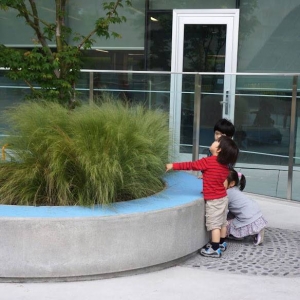 Native grasses can be just as delightful as exotic plants
(Surrey City Hall Childcare | space2place landscape architects)
Native grasses can be just as delightful as exotic plants
(Surrey City Hall Childcare | space2place landscape architects)
 Some of the prettiest wildflowers could be growing in your own back yard
(Hinge Park | PWL Partnership Landscape Architects Inc.)
Some of the prettiest wildflowers could be growing in your own back yard
(Hinge Park | PWL Partnership Landscape Architects Inc.)
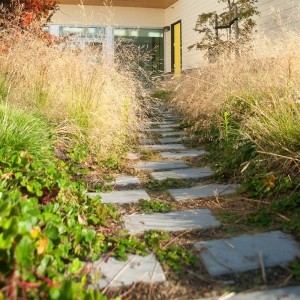 Grasses line the pathway to the kindergarten door
(Samuel Brighouse Elementary School Perkins + Will | Image: Nic Leroux)
Grasses line the pathway to the kindergarten door
(Samuel Brighouse Elementary School Perkins + Will | Image: Nic Leroux)
Gardens and Agriculture
Incorporating gardens, especially gardens that produce food, can have many benefits in a schoolyard. A garden can be a way to educate kids about ecology and food production and give them hands-on experience and skills. It’s fun, too! Having kids participate in a garden project can also be a way to connect to the community. The harvest can be sold for fundraising or contribute to food security initiatives, to name just a few.
Gardens can also be just about any shape or size, making it easy to make use of any leftover or underused spaces. This makes it easy to take a space from Grey to Green.
Want to learn more about kids and community gardens? Check out Fresh Roots, an initiative in partnership with the Vancouver School Board that helps schools and communities to create edible schoolyards.
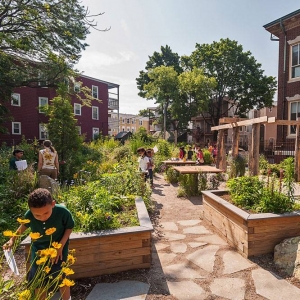 Raised planters with rich soil can be put just about anywhere
(Boston Schoolyard Initiative | Kloepfer Martin Design Group)
Raised planters with rich soil can be put just about anywhere
(Boston Schoolyard Initiative | Kloepfer Martin Design Group)
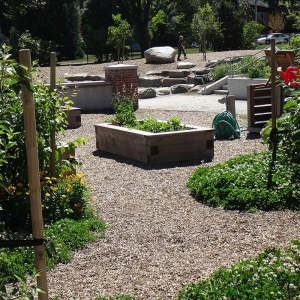 Community garden planters and clover pods
(Lord Kitchener Elementary School | Jonathan Losee Ltd. Landscape Architecture)
Community garden planters and clover pods
(Lord Kitchener Elementary School | Jonathan Losee Ltd. Landscape Architecture)
Recycled Materials
Reusing previously used materials not only diverts those materials from ending up in a landfill; it can also save a lot of money. Recycled materials have become quite a trend as they can lend themselves to some very creative and playful uses. See our Recycled Recreation section for some inspirational projects that have made a huge impact and turned trash to treasure.
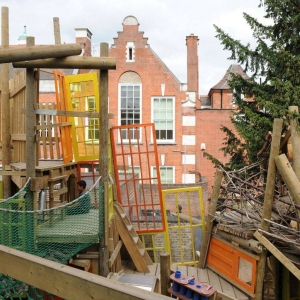 Colourful doors and windows create a wall along stairs
(Kilburn Grange Adventure Play Park |erectarchitecture | Image: David Grandorge)
Colourful doors and windows create a wall along stairs
(Kilburn Grange Adventure Play Park |erectarchitecture | Image: David Grandorge)
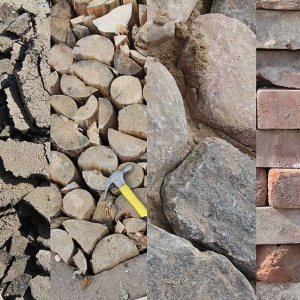 Recycled asphalt, wood, stones, and bricks
(Folly Forest | Straub Thurmayr Landscape Architects and Urban Designers)
Recycled asphalt, wood, stones, and bricks
(Folly Forest | Straub Thurmayr Landscape Architects and Urban Designers)
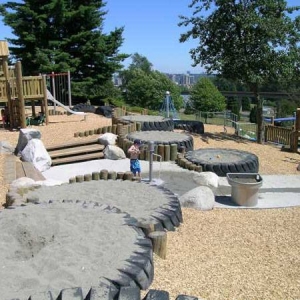 Huge tires are used as a series of sandboxes
(Grimston Park Playground | Richard Findlay Landscape Architect Inc.)
Huge tires are used as a series of sandboxes
(Grimston Park Playground | Richard Findlay Landscape Architect Inc.)
Natural and Local Materials
Humans have been using natural materials like wood, stone, and metal since the Bronze Age. That must be why they feel so classic and authentic. These materials can have a low environmental impact if sourced locally by reducing the distance they have to travel. Local materials can also give a project a real sense and flavour of “home”, especially if they’re unique to your area. Natural materials tend to age better than some synthetic materials. Plastic, for instance, will degrade over time from the sun’s UV rays, causing it to lose colour and become brittle. And let’s not forget that a lot of natural materials can find a second life as recycled materials!
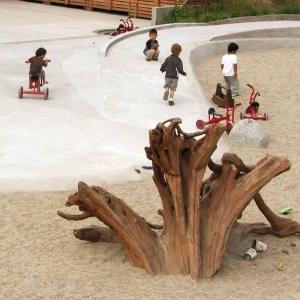 A large piece of driftwood sparks the imagination
(SFU UniverCity Childcare | space2place landscape architects)
A large piece of driftwood sparks the imagination
(SFU UniverCity Childcare | space2place landscape architects)
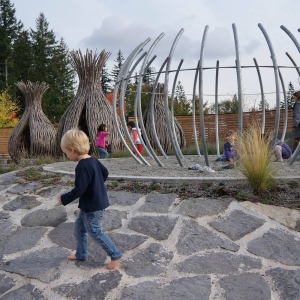 Stone ground, metal cage, and stick huts
(SFU UniverCity Childcare | space2place landscape architects)
Stone ground, metal cage, and stick huts
(SFU UniverCity Childcare | space2place landscape architects)
 log sections define space
( Djavad Mowafaghian Child Care Centre | Jonathan Losee Ltd. Landscape Architecture)
log sections define space
( Djavad Mowafaghian Child Care Centre | Jonathan Losee Ltd. Landscape Architecture)
